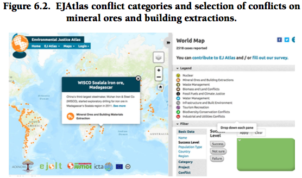
By Mariana Walter, Lena Weber, Leah Temper.
Abstract
In this paper we examined how the Environmental Justice Atlas (EJAtlas),1 an online platform that was initially developed to make visible and systematize contemporary struggles against environmental injustice worldwide— with and for affected groups—is becoming an attractive interactive tool to teach and learn about environmental and sustainability concepts and trends from an engaged and innovative approach. Since its launch in 2012, the EJAtlas has become a research, teaching, networking, and advocacy resource with thousands of daily visits. As of January 2019, it contains 2,684 cases, worldwide. Strategists, activist organizers, scholars, and teachers are finding many uses for the database, as well as citizens wanting to learn more about the often invisible conflicts taking place. The map has become a valuable teaching resource for curricula about social and environmental issues. It has also fulfilled a valuable networking function connecting groups and actors globally. According to a survey responded to by Atlas users (600 responses), over 37% of Atlas survey respondents report using the EJAtlas for teaching and presentations, representing the most common use of the Atlas by visitors.
As developed in this special issue, different scholars and policy makers are signaling the improvement of environmental education tools to teach about sustainability as a key strategy to address ongoing environmental crises (Cotton and Winter 2010), and the need to further develop adequate tools to address this complex issue (Besong and Holland 2015). Yet, among this broader improvement and development of tools for sustainability education, there is a noted lack of resources for and inclusion of environmental justice curricula that is attendant to issues of racism, poverty, capitalism, and inequalities (Garibay et al. 2016), reflective of the historical exclusion of marginalized communities from mainstream environmentalism (Garibay and Vincent 2018).
As argued by Bowman (2010, 2011), Denson (2009), and Engberg (2004) in Garibay et al. (2016), diversifying perspectives in curriculum can improve students’ civic behavior and cognitive development while diminishing prejudices toward marginalized groups. Furthermore, interdisciplinary environmental and sustainability programs in the United States with more diverse voices included in their curricula tend to increase enrolment of minority students (Garibay and Vincent 2018), suggesting that use of a pedagogical tool like the EJAtlas can have real implications for Bonta’s (2008) call to diversify the educational pipeline into environmental work. Moreover, literature on environmental justice education tends to focus on debates and experiences in the United States (Garibay et al. 2016). Examining EJAtlas pedagogical uses allows us to broaden environmental justice education considerations including experiences and challenges from other contexts (countries, languages, approaches to environmental justice).
In the context of these debates, this paper presents initial results of an ongoing systematization and analysis of the pedagogical uses of the Environmental Justice Atlas (www.ejatlas.org). This research aims to explore how environmental justice is being included in higher education curricula—as proposed by Garibay and colleagues (2015)—with the EJAtlas and to examine why and how the EJAtlas is used for teaching/learning environmental justice and sustainability.
This chapter develops empirical, conceptual, and practical contributions. From an empirical approach we aimed to study how the EJAtlas is used in (formal) teaching. What is taught, to whom and which were the main challenges and lessons. From a conceptual perspective we aimed to examine how the EJAtlas contributes to environmental justice and sustainability teaching/learning debates. Finally, this research is part of a larger effort to improve the functionality of the online platform for pedagogical uses, identifying technical and content development needs.
After this introduction, we briefly address some relevant debates in learning studies to which the paper contributes. Next, we present the EJatlas, its origins and conceptual background. Moving onward, we outline our methodological approach to examine the main uses of the EJAtlas as a pedagogical tool, we present the results and discuss the main conceptual ndings. Finally, we conclude the chapter with closing remarks.
More info
DOI: 10.1002/tl
Chapter in New Directions for Teaching and Learning. Special Issue: Teaching and Learning about Sustainability in Higher Education. Volume2020, Issue161. Spring 2020, Pages 101-121.

The project ENVJUSTICE has received funding from the European Research Council (ERC) under the European Union’s Horizon 2020 research and innovation programme (grant agreement No. 695446)